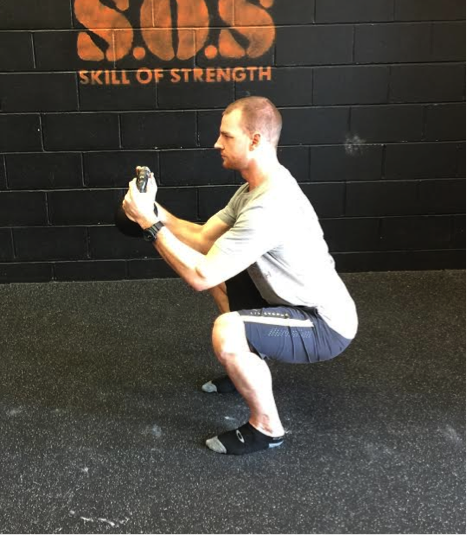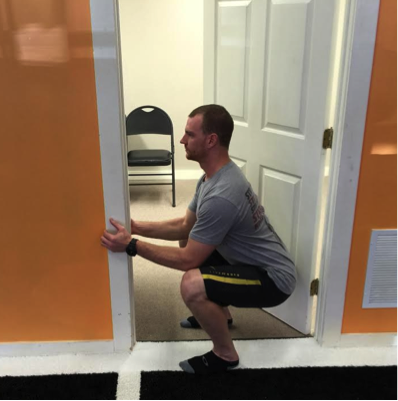
The wall-sit is a very common exercise used by athletes and coaches as a regression to the squat, or as a lower body strengthening exercise. You won’t see me selecting wall-sits for my athletes at Skill of Strength. Today I’ll share with you why I have beef with wall-sits and what I use instead!
Frankly, I don’t have enough time with my athletes to give them 15 exercises to do every day. Who does? Therefore, the majority of the exercises that make up our sports performance (and all!) strength training programs here at Skill of Strength generally serve 2-3 purposes each.
That’s right…no fluff, no fillers!
What’s my beef with the wall-sit?
1. The positioning of the wall-sit does not transfer well to other squat styles or other movements in sports performance.
The bottom position of the wall sit calls for a vertical shin angle and a vertical torso angle. This position is not conducive to common squat styles.
- A front squat or goblet squat, which typically calls for a more vertical torso must be performed with a rather large (in comparison) shin angle.
- A low bar back squat, which has a more vertical shin angle, requires a larger torso angle.
Given the two points above, which squat are you really trying to teach by using the wall-sit as a teaching tool?
Notice that if you see someone doing a wall-sit, it really just looks like they’re trying to prevent the wall from falling over. If that’s the case, you’re doing a really inefficient job at it!
2. Squats require a lot of ankle mobility.
A wall-sit requires very little ankle mobility. Again, thanks for not helping prepare for squats at all, wall-sit!
Okay, so the wall sit sucks. What now?
Depending on an individual’s difficulty with the squat, I would prefer to use other squat regressions that more closely mimic the mobility requirements and patterning of the squat.
The goblet squat serves this purpose extremely well, because the kettlebell can be used as a bit of a counter balance, making it a great regression.

You can also assist the squat using a door frame or TRX!


“Sure, okay goblet squats are great, but wait! Aren’t isometrics awesome for youth athletes? Don’t they have positive strength benefits?”
…I totally agree with you internet voice! 😉
I really like using isometric exercises, especially for training the lower body. I tend to use isometric exercises to promote lower extremity stability and pelvic stability in various joint ranges. So, I agree that using an isometric exercise, similar to a wall-sit, but with better transfer capabilities, is a great idea.
Here is how I’ve changed the wall-sit to better suit the needs of our youth sport performance athletes!
Rather than getting my athletes into the bottom of a wall-sit, I position them in the bottom of a hip hinge – a hip-dominant position rather than a knee-dominant position.
Why is the hip hinge iso better than the wall-sit?
1. The hip hinge iso is versatile.
As I mentioned above, I don’t have time for 15 exercises and neither do you.
- By practicing the hip hinge position, you’re mimicking the bottom position of the deadlift and kettlebell swing, and the beginning and landing (decelerated) positions of a jump.
- Hip hinge isos also increase mobility in the muscles of the posterior chain.
For you New Englanders, even Bill Belichick would appreciate the hip hinge iso’s versatility!
2. The hip hinge iso provides a common reference point for many other exercises.
By teaching my athletes this one exercise, the hip hinge iso, it gives me a common reference position. For example, if I am teaching athletes to do a hurdle hop for the first time, I can ask them to begin in the “hip hinge iso.” Boom – they can utilize a skill they already have to help them learn a new skill!
Takeaways
When I select exercises to include in our sports performance training programs at Skill of Strength, each exercise absolutely must benefit the athletes. I need to know exactly why I’m including each exercise in a program.
The wall-sit is an exercise coaches commonly use. My guess is most of them don’t really know what athletes are gaining from wall-sitting. Or perhaps it’s that coaches believe athletes are benefitting from the exercise in ways they likely are not.
If you are a coach, I encourage you to make your strength training programs significantly less lame by ditching the wall-sit. Instead, add in exercises that athletes will actually benefit from practicing, like the goblet squat, TRX squat and the hip hinge iso!
